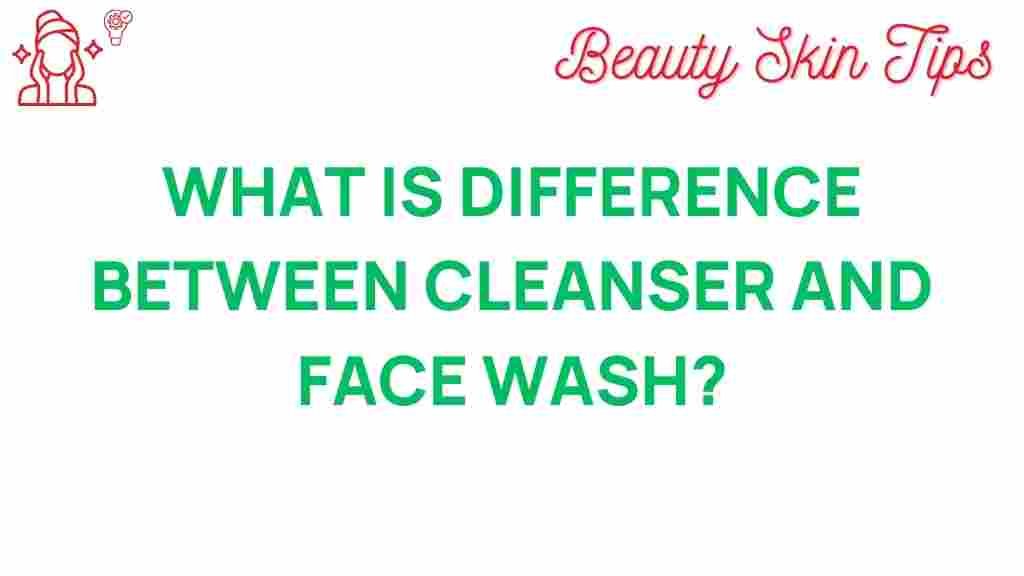Cleansers vs. Face Wash: What’s the Real Difference?
When it comes to skincare, one of the most fundamental steps is cleansing. However, the terms “cleansers” and “face wash” are often used interchangeably, leading to confusion among skincare enthusiasts. Understanding the real difference between these two products is essential for establishing an effective skincare routine. In this article, we will delve into what cleansers are, how they differ from face washes, and how to choose the right product for your skin type.
What Are Cleansers?
Cleansers are skincare products designed to remove dirt, makeup, and impurities from the skin. They come in various forms, including creams, gels, oils, and micellar water. Cleansers can be formulated with different ingredients to cater to various skin types and concerns. They are generally milder than face washes and can provide additional benefits such as hydration and nourishment.
The Role of Face Wash
Face wash, on the other hand, is typically a foaming or gel-based product that focuses primarily on deep cleaning the skin. It is formulated to cleanse the surface of the skin and remove excess oil, sweat, and impurities. While face wash can be effective, it may strip the skin of its natural oils, which can lead to dryness or irritation, especially for those with sensitive skin.
Key Differences Between Cleansers and Face Wash
Understanding the distinctions between cleansers and face washes can help you make informed choices for your skincare routine. Here are the primary differences:
- Ingredients: Cleansers often contain moisturizing agents and soothing ingredients, while face washes may include more aggressive surfactants designed for deep cleaning.
- Texture: Cleansers can be creamy, oily, or milky, whereas face washes are typically gel or foam-based.
- Skin Type Suitability: Cleansers are generally suitable for all skin types, including dry and sensitive skin. Face washes tend to be better for oily or acne-prone skin.
- Purpose: Cleansers can offer multiple benefits beyond just cleaning, such as hydration, while face washes primarily focus on cleansing.
Types of Cleansers
Cleansers come in various types, each catering to different skin needs:
- Oil Cleansers: These are effective for removing makeup and impurities without stripping the skin’s natural oils.
- Cream Cleansers: Perfect for dry or sensitive skin, cream cleansers provide hydration while cleansing.
- Gel Cleansers: Ideal for oily or combination skin, gel cleansers help control oil and breakouts.
- Micellar Water: A gentle option that attracts dirt and makeup like a magnet, micellar water requires no rinsing.
How to Choose the Right Cleanser
Choosing the right cleanser is crucial for maintaining healthy skin. Here’s a step-by-step process to help you select the best product for your skin type:
- Identify Your Skin Type: Determine whether your skin is oily, dry, combination, or sensitive.
- Check the Ingredients: Look for ingredients that cater to your skin needs. For example, glycerin and hyaluronic acid for hydration, or salicylic acid for acne-prone skin.
- Consider Your Concerns: If you have specific concerns like acne or aging, select cleansers with targeted ingredients.
- Test the Product: Whenever possible, try a sample before committing to a full-size product to ensure it works well with your skin.
When to Use Cleansers and Face Wash
Incorporating both cleansers and face washes into your skincare routine can be beneficial. Here’s how to use them effectively:
Morning Routine
- Start with a gentle cleanser to remove any oils or sweat that accumulated overnight.
- If you have oily skin, follow up with a face wash to remove excess oil.
Evening Routine
- Begin with an oil cleanser or micellar water to remove makeup and impurities.
- Follow up with a face wash for a deeper clean.
Weekly Exfoliation
In addition to your regular cleansing routine, consider incorporating an exfoliating product once or twice a week. This helps remove dead skin cells and promotes a brighter complexion. Remember to use a gentle exfoliator that suits your skin type.
Troubleshooting Common Issues
Even with the right products, you may encounter some issues. Here are troubleshooting tips for common cleansing concerns:
Dryness or Tightness
- If your skin feels dry or tight after cleansing, consider switching to a cream cleanser or reducing the frequency of face wash use.
- Ensure you are using a hydrating moisturizer after cleansing to lock in moisture.
Breakouts
- If you experience breakouts, opt for a gel cleanser with salicylic acid or benzoyl peroxide.
- Ensure you’re cleansing twice daily to keep pores clear, but avoid over-cleansing, which can worsen breakouts.
Makeup Residue
- If you find makeup residue after cleansing, try using an oil cleanser as the first step in your routine.
- Follow up with a face wash to ensure all impurities are removed.
Conclusion
In summary, understanding the difference between cleansers and face wash is vital for achieving healthy skin. Cleansers offer a gentle way to remove impurities while providing hydration and nourishment, making them suitable for all skin types. Face washes, while effective for deep cleaning, may not be ideal for everyone, especially those with dry or sensitive skin.
By identifying your skin type, checking ingredients, and following a proper cleansing routine, you can maintain a radiant complexion. Remember, skincare is personal; what works for one person may not work for another. For more information on skincare routines, feel free to check out this detailed guide.
For further reading on the science behind skincare ingredients, visit this external resource.
This article is in the category Skincare and created by BeautySkinTips Team
